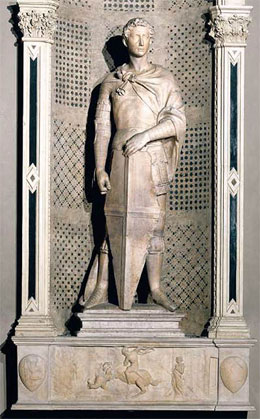St. George
”St. George” is the second of Donatello's Orsanmichele statues. It was commissioned by the Arte dei Corazzai e Spadai (the Guild of Armourers) and executed in marble, as was the custom for a guild which was not considered a major one. The statue is now at the Bargello, and the original Tabernacle contains a bronze cast.
St. George history
Donatello received the commission for the statue in 1416. It appears that the niche in which the St. George sculpture was placed is shallower than all the others, because of the belfry stairs built in the thickness of the wall. This leaved the work more exposed to wind and rain than any other statue at Orsanmichele.

Donatello - St. George
Museo Nationale del Bargello, Florence
As early as 1628, the bronze colored paint which covered the statue was almost destroyed by weather. In order to save it, the statue was removed from its Tabernacle, and relocated to that of the Guild of Physicians, made available by taking their statue, “Madonna della Rosa”, inside the church. The new location was better protected against the weather, as it was on the south side. In 1886, the statue of St. George was transferred to the Bargello, and the bronze cast took its place in the niche at Orsanmichele.
St. George: Donatello’s masterpiece
Vasari's was very appreciative of this work, and his fine criticism captured the essence of Donatello’s work more than any other volumes praising the sculpture. He noted that the statue of St. George in his armour, with its “vivacity terrible and audacious” reflects the beauty of youth, and the moral values of courage and chivalry. The marvelous gesture and the life-like appearance are giving the impression that “the spirit stirred within the stone.”
And this is exactly what is so specific to many of Donatello’s sculptures: his unique skill of capturing a transitory expression in such a manner that the figure seems alive.
The statue is probably the most popular of Donatello's works. It has a youthful beauty, a boyish modesty, and great delicacy. It conveys the values of chivalry, in a time when many young citizens of Florence were behaving like the chivalric ideals never existed. The sculpture appealed strongly to the feelings of the patriotic Florentine public, anxious to find examples which could inspire their sons.
The radiant figure of St. George embodies the self-reliant, hopeful spirit of the Renaissance in general, and the independent nature of Florence people. It has the fearless simplicity of an heroic medieval knight, inspired by the early days of the pure and religious chivalry. Donatello acknowledged the classical superiority, inspired by it he created his own form of classic, but the heroic knight ideal is purely medieval.
The nature of its pose is one of the most difficult to achieve, that of rest, however you can also see the figure’s strength. He stands in his niche, holding the shield in front of him with the point resting on the ground. His head is set proudly on the long neck, facing the world with frank, resolute eyes. St. George armor is simple, and is not contemporary. It is a finely modeled Roman breastplate showing every curve of the muscles. The legs are somewhat thick and coarse, and the hands, large and roughly carved, are typical for Donatello’s earlier sculptures.
St. George artistic influence
Donatello’s statue heavily influenced the art of his contemporaries. The beauty of the youth, the ideal of chivalry were so brightly illustrated by his sculpture, that any Saints or young warriors statues or paintings have reminiscences of St. George.
Signorelli imitated and exaggerated the defiant attitude, creating his own with an almost arrogant and aggressive posture. Andrea del Castagno used the St. George statue as a source of inspiration when he created his fresco of Pippo Spano of Legnaia, a Florentine military commander seen as an incarnation of intrepid courage.
Mantegna copied Donatello’s sculpture almost exactly in his Eremitani fresco, and more freely in his painting of “St. George”, now in the Venice Accademia. St. George became so popular that artists were simply copying the statue. In the cortile of the Palazzo Quaratesi, built by Brunelleschi between 1425 and 1430, there is a marble copy of the head, proving how early it had become so popular.
St. George Tabernacle
The Tabernacle at Orsanmichele is also the work of Donatello, and its relief representing the "Slaying of the Dragon" completes the subject. It represents the combat of the saint, a superb knight, with the dragon, while a visibly emotional princess Sabra is standing by with her hands pressed together, her knees shaking.
Using his particular bas-relief technique, Donatello created one of the most beautiful and poetic of his sculptures. St. George is shown plunging his lance into the throat of the dragon. Behind him stands the classic, graceful Princess of Cappadocia, a figure which proves Donatello’s capacity to express softness and grace. It is a skill which will be later revealed even more strongly by his Virgin of the “Annunciation” in Santa Croce.
Donatello’s proficiency in using the bas-relief allowed the artist to achieve a scene atmosphere which is probably impossible to obtain by anybody else using means so slight. The wooded landscape, the cave of the dragon, the colonnade of the palace, with its open door and long passage, the wind-blown trees, everything is so illusively presented on a nearly flat surface of marble, with an amazing pictorial effect.
The statue of "St. George" is a supreme triumph of the Renaissance art, which can stand side by side with any of the classical antiquity masterpieces.
Donatello: Life and sculptures
The marble and bronze David statues